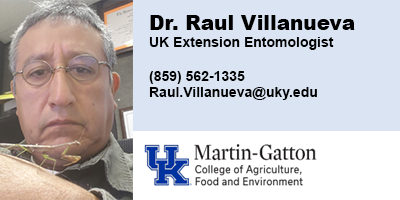Hessian fly threat persists in Kentucky wheat fields ahead of 2025 fall planting
Hessian fly threat persists in Kentucky wheat fields ahead of 2025 fall planting


During 2025, field monitoring of wheat planted outside the normal season for research purposes at the University of Kentucky Research and Education Center (UK-REC) in Princeton revealed wheat plants with stunted growth and yellowing leaves (Figure 1). Inspection of these plants showed the presence of Hessian fly (Mayetiola destructor; Diptera: Cecidomyiidae) larvae beneath the leaf sheaths (Figure 2). These findings highlight the need for proactive monitoring and management as we enter the new planting season and confirm that the Hessian fly can persist in Kentucky fields when favorable conditions such as sustained temperatures above 55°F, are present. As Kentucky wheat growers prepare for the 2025 fall planting season, and with current environmental conditions appearing favorable for Hessian fly persistence, the threat from this pest remains very real.
Understanding the Hessian Fly Life Cycle
The Hessian fly develops through four life stages (Figure 3a–3d): egg, larva, pupa (flaxseed), and adult. Adults are small, gnat-like flies that emerge in two main generations each year—one in the fall and another in the spring.
- Eggs are laid on young wheat leaves, typically during cool, moist conditions.
- After hatching, larvae crawl down the leaf and settle at the base of the plant behind the sheath. This is the damaging stage, as they feed and disrupt nutrient flow.
- The larvae then form a hard, brown casing known as a flaxseed, in which they overwinter or pupate.
- Adults emerge from the flaxseed to begin the next generation.
In Kentucky, early planting can coincide with the fall emergence of adults, exposing young wheat to heavy egg-laying. This is why planting after the fly-free date is critical for reducing Hessian fly pressure.

The Significance of Hessian Fly
This tiny midge's larvae disrupt the flow of nutrients by feeding close to the plant crown. Symptoms of damage include dead or yellowed leaves, stunted or weak tillers. Plant collapse or lodging. Early prevention is crucial because insecticides lose their effectiveness once the larvae are inside the plant.
What to Look for:
Scouting is essential, particularly in fields that were planted early.
- When to scout: 2 - 3 weeks after planting or tillering.
- Where to look: Peel back leaf sheaths close to the base.
- Signs to check: Stunted plants, collapsed stems, or tiny, legless white or red larvae.
- Threshold: >20% infested tillers may result in a considerable loss of stand.
Monitoring in Wheat Planted Out of Season in 2025

For research purposes, we planted wheat during the summer. In this field, we placed delta traps in grassy areas adjacent to wheat plots at the University of Kentucky Research and Education Center in Princeton. Each delta trap contained a yellow sticky card, and in some traps, we also added a pheromone lure specific to the Hessian fly (Figure 4).
The objective of this study was to evaluate whether Hessian flies are more effectively detected using plain sticky cards or sticky cards equipped with pheromone lures.
What We Found and Its Importance
Traps equipped with pheromone lures consistently captured more Hessian flies than traps containing only sticky cards (Figure 5). Fly activity was detected in July and August, prior to wheat planting. Although yellow sticky cards without lures did capture flies, the numbers were much lower compared to pheromone-baited traps.

These findings indicate that, while sticky cards alone can detect Hessian flies, their effectiveness is limited—particularly when used inside delta traps. In contrast, pheromone-baited traps provide a more reliable measure of fly activity, giving farmers, consultants, and extension agents a clearer understanding of population densities in fields. Detecting Hessian flies before wheat planting underscores the importance of adhering to the recommended fly-free planting date to minimize the risk of early infestations.
Tips for Fall Management
- Plant after the fly-free date: Peak adult emergence can be avoided by planting after the fly-free date, which typically occurs in mid-October in Kentucky (Figure 6).
- Plant resistant varieties: Whenever possible, select cultivars known to be resistant to the Hessian fly.
- Use seed treatments: Although not a complete solution, insecticide seed treatments can help reduce early larval establishment.
- Clean the fields: Rotate with non-host crops such as corn or soybeans, control grassy weeds, and destroy volunteer wheat to minimize overwintering sites.

| Citation: Adewinle, A., Villanueva, R., 2025. Hessian Fly Threat Persists in Kentucky Wheat Fields Ahead of 2025 Fall Planting. Kentucky Field Crops News, Vol 1, Issue 10. University of Kentucky, October 10, 2025. |

|

|
